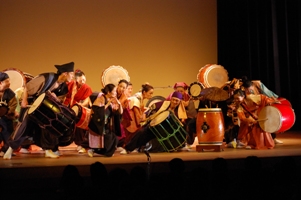 |
Fukuoka No Ichi (The Markets of Fukuoka)
By Higashi Munenori |
| This piece was written especially for Meito Daiko in 1990. In this, the first act of the Requiem for the Swordsmiths," the bustling market town of Fukuoka is re-created on stage. The "communication" between players is a rhythmical representation of the haggling between shopkeeper and customers. |
 |
Shutsujin
By HIGASHI Munenori
|
| This piece was written in 2007 especially with Meito Daiko's 20th Anniversary Concert (Feb. 2008) in mind. Shutsujin means "mobilizing the troops" and the piece expresses the sounds of a samurai army heading to the battlefront. |
 |
 |
HachijoBayashi
Traditional
(Arr. HIGASHI
Munenori)
(Choreography: Meito Daiko) |
| The island of Hachijo (Hachijojima) was effectively a prison to which political enemies were banished. The convicts sent there immensely missed their wives and children, and focused their energies on beating drums and singing of their hometowns. This song expresses their longing to be reunited with their families as well as their hopes for a peaceful future. Today the song still carries meaning as a message for peace. |
 |
 |
Miyake
Traditional
(Arr. Meito Daiko) |
| Miyake Island is one of the seven islands of the Izu Archipelago where a particular style of taiko drumming, known as gkiyari taikoh originates. The traditional style uses a single nagado (long-bodied) drum, which is placed low to the ground and beaten from
both sides. Meito Daiko's arrangement uses multiple drums but preserves
the tradition by incorporating solo performances also. |
 |
 |
ChoshiHayauchi
By Higashi Munenori |
| Choshi is a peninsula in present day Chiba Prefecture, near Tokyo. This
piece uses the rhythm of the drums and the movements of the drummers to
express the waves of the Pacific Ocean as they bounce off the rocky coast.
There are distinct stages in the piece, expressing a calm sea, which gradually
builds into a storm. |
 |
 |
YataiBayashi
Traditional
(Arr. Meito Daiko) |
| Every year on the third of December, a festival involving a portable shrine (called a yatai), is held in the city of Chichibu in Saitama Prefecture. These floats, which weigh more than 10 tonnes, are moved by the combined effort of many people pulling on ropes. Music is played from inside the floats so that the team may better coordinate their efforts. The constricted posture originates from the confined space inside the float. |
 |
 |
Fukkatsueno Tsuchioto
By Higashi Munenori |
| This piece was written especially for Meito Daiko in 1990. It is one act of the three part Requiem for the Swordsmiths," which honors the founders of Meito-Daiko's hometown. The master swordsmiths usually worked with two or three apprentices. It is extremely rare to have a waltz-like 3-beat rhythm in a taiko piece, but it is easy to make the connection between this rhythm and the sound of the three apprentices' hammers as they strike the anvil in turn. |
 |
 |
Buchiawase
By Higashi Munenori
(Choreography: Meito
Daiko) |
| There was once a harbour town in which an unusual festival was held involving
two boats each with taiko drums aboard. The drummers of the two boats competed
with each other and the drum from the losing boat was tossed into the sea.
Inspired by this story, Mr. Higashi wrote this piece in which two teams
of drummers compete with each other. |
 |
 |
Taiza
By Higashi Munenori
(Choreography: Meito
Daiko) |
| This piece involves a little audience participation. We hope that
you feel inspired to help us out by clapping along and joining the chant of
gYoisa, Yoisa!h |